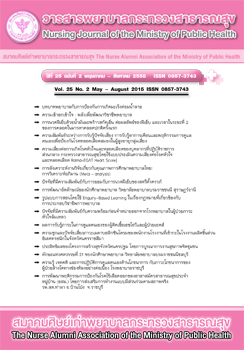ความสัมพันธ์ระหว่างการรับรู้ปัจจัยเสี่ยง การรับรู้อาการเตือนและพฤติกรรมการดูแลตนเองเพื่อป้องกันโรคหลอดเลือดสมองในผู้สูงอายุกลุ่มเสี่ยง
Main Article Content
Abstract
บทคัดย่อ
การวิจัยครั้งนี้เป็นการศึกษาหาความสัมพันธ์ระหว่างการรับรู้ปัจจัยเสี่ยง การรับรู้อาการเตือนและพฤติกรรมการดูแลตนเองเพื่อป้องกันโรคหลอดเลือดสมองในผู้สูงอายุกลุ่มเสี่ยง กลุ่มตัวอย่างเป็นผู้สูงอายุเพศชายและหญิงอายุ 60-79 ปี ที่มีความเสี่ยงต่อการเกิดโรคหลอดเลือดสมองจำนวน 85 ราย ที่เข้ารับบริการที่ห้องตรวจอายุรกรรม โรงพยาบาลนครปฐม เครื่องมือที่ใช้ในการเก็บข้อมูลได้แก่ แบบสัมภาษณ์ข้อมูลส่วนบุคคล แบบสัมภาษณ์การรับรู้ปัจจัยเสี่ยง แบบสัมภาษณ์การรับรู้อาการเตือน และแบบสัมภาษณ์พฤติกรรมการดูแลตนเองเพื่อป้องกันโรคหลอดเลือดสมองในผู้สูงอายุกลุ่มเสี่ยง เครื่องมือทุกฉบับได้รับการตรวจสอบความตรงตามเนื้อหาโดยผู้ทรงคุณวุฒิจำนวน 4 ท่านและหาค่าความเที่ยงด้วยวิธีสัมประสิทธิ์อัลฟ่าของครอนบาค เท่ากับ 0.82 0.85 และ 0.71 ตามลำดับ วิเคราะห์ข้อมูลโดยใช้สถิติสัมประสิทธิ์สหสัมพันธ์เพียร์สัน ผลการศึกษาพบว่า กลุ่มตัวอย่างเป็นเพศหญิงร้อยละ 60 อายุเฉลี่ย 70.16 ปี (SD=5.64) การรับรู้ปัจจัยเสี่ยงอยู่ในระดับสูงร้อยละ 63.5 โดยปัจจัยเสี่ยงที่มีการรับรู้มากที่สุด คือโรคความดันโลหิตสูง ร้อยละ 83.5 การรับรู้อาการเตือนอยู่ในระดับสูงร้อยละ 75.3 โดยมีการรับรู้ว่า อาการอ่อนแรงของกล้ามเนื้อใบหน้า แขน/ขา ข้างใดข้างหนึ่งอย่างทันทีทันใดเป็นอาการเตือนที่มีการรับรู้มากที่สุด ร้อยละ 92.9 และพฤติกรรมการดูแลตนเองเพื่อป้องกันโรคหลอดเลือดสมองในผู้สูงอายุกลุ่มเสี่ยงอยู่ในระดับสูง ร้อยละ 82.4 โดยพฤติกรรมที่มีการปฏิบัติเป็นประจำคือ การงดหรือลดการสูบบุหรี่ หรือหลีกเลี่ยงการอยู่ในสถานที่ที่มีควันบุหรี่ ร้อยละ 97.6 การรับรู้ปัจจัยเสี่ยงไม่มีความสัมพันธ์กับพฤติกรรมการดูแลตนเองเพื่อป้องกันโรคหลอดเลือดสมอง (p > .05) และการรับรู้อาการเตือนมีความสัมพันธ์ทางบวกกับพฤติกรรมการดูแลตนเองเพื่อป้องกันโรคหลอดเลือดสมองอย่างมีนัยสำคัญทางสถิติ (r = .201, p < .05) การให้ข้อมูลสุขภาพเกี่ยวกับอาการเตือนของโรคหลอดเลือดสมองในผู้สูงอายุ เป็นสิ่งที่จำเป็นในการส่งเสริมพฤติกรรมการดูแลตนเองเพื่อป้องกันโรคหลอดเลือดสมองในผู้สูงอายุกลุ่มเสี่ยง
Relationships between Perceived Risk, Perceived warning signs and self-care behavior in Older adults at risk of Cerebrovascular Disease*
Karnthicha Kumpangkaew**
Wilaipun Somboontanont***
Venus Leelahakul****
Abstract
The present study was aimed at investigating the relationships among perceived risk, perceived warning signs, and self-care behavior in older adults at risk of cerebrovascular disease. The study sample consisted of 85 males and females who were between 60 to 79 years of age who were at risk of cerebrovascular disease who sought treatment at the medicinal ward of Nakhon Pathom Hospital. The instruments used in data collection included the demographic data form, the perceived risk interview form, the perceived warning signs interview form, and the self-care behaviors to prevent cerebrovascular disease in older adults at risk interview form. All of the instruments were checked for content validity by 4 experts. Cronbach’s alpha correlation coefficient revealed that the reliability of the perceived risk interview protocol, the perceived warning signs interview protocol, and the self-care behaviors to prevent cerebrovascular disease in older adults at risk interview protocol were equal to 0.82, 0.85, and 0.71, respectively. Data were analyzed using Pearson’s product moment correlation coefficient. The study findings showed that 60% of the subjects were female. Their mean age was 70.16 years (SD = 5.64). Their perceived risk was at a high level score at 73.5% a. It was found that hypertension was the perceived risk with the highest score at 83.5%, and their overall perceived warning signs were also at a high level score at 75.3%, with almost all of the subjects, or 92.9%, had the perception that immediate myasthenia gravis of the facial muscles or limb muscles were the perceived warning signs with the highest score. Moreover, the findings revealed that the subjects had a high level of self-care behaviors to prevent cerebrovascular disease. The behavior that was found most frequently was smoking reduction or cessation or avoidance of places with cigarette smoke, accounting for 97.6%. Finally, it was discovered that perceived risk was not related to self-care behaviors to prevent cerebrovascular disease (p > 0.05), but perceived warning signs were positively related to self-care behaviors to prevent cerebrovascular disease with a statistical significance (r = 0.201, p < 0.05). Based on the study findings, the health information regarding warning signs of cerebrovascular disease in older adults is necessary to promote self-care behaviors in older adults at risk of cerebrovascular disease.
*Master Thesis of nursing Science (Gerontological Nursing). Faculty of Nursing, Mahidol University.
**Register Nurse, Nakhon Pathom Hospital
*** Assistant Professor Dr., Faculty of Nursing, Mahidol University (co-responding author)
****Associate Professor Dr., Faculty of Nursing, Mahidol University.
Article Details
บทความและรายงานวิจัยในวารสารพยาบาลกระทรวงสาธารณสุข เป็นความคิดเห็นของ ผู้เขียน มิใช่ของคณะผู้จัดทำ และมิใช่ความรับผิดชอบของสมาคมศิษย์เก่าพยาบาลกระทรวงสาธารณสุข ซึ่งสามารถนำไปอ้างอิงได้

